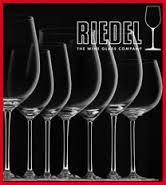Does the glassware make a difference or is it wishful thinking?
By: Louis Marmon
November 14, 2016

There are many ways that what we trust to be true affects our perceptions, especially when tasting wine. Myriad factors influence our impressions when wine-tasting including the temperature, price, color, background music, accompanying cuisine and ambiance. The experience is changed by what the mind expects.
But can you say the same for stemware? There is little doubt (and some actual scientific evidence) that the shape of the glass does affect the volatility of the compounds that determine a wine’s aroma. Bigger surface areas, including the inside walls of the glass (hence the swirl), increase the amount of chemicals that move into the air.
The question is whether a particular varietal requires a specifically shaped glass in order to be able to completely appreciate its character?
Georg Riedel certainly believes the answer is a resounding “yes.” The 10th-generation owner of the Austrian based glassware company exuded a low-key confidence and old-world charm as he explained that his glasses “cannot make a bad wine good,” but instead “elevate the components” to enhance their characteristics.
As way of demonstration he lined up Riedel glassware specific for Pinot Noir, Syrah and Cabernet Sauvignon and poured ice-cold bottled Fiji water into each. We were instructed to sip from them separately and to note that each glass caused distinctive areas in our mouths to become cold. For the Pinot glass it was the front of the mouth, the Syrah specific shape chilled the tongue and palate toward the back of the mouth while the Cabernet configuration caused more widely central mouth coldness. The different sensations, Riedel said, was due to the geometry of the goblet which directed the liquid to specific oral locations.
We then did a series of tastings for each varietal. A Pinot Noir based wine was delightful in its custom Riedel glass, tasted significantly different in the Syrah stemware and was basically unpalatable from the Cabernet glass. These impressions were repeated when Syrah and Cabernet Sauvignon were sampled in their “correct” glass as compared to the other stem designs.
But I cannot help feeling that somewhere Penn and Teller are chuckling. The problem is that the taste of a complex liquid like wine is less dependent upon the palate and tongue as it is upon the specialized sensory tissues within the nose. Taste buds are present only on the tongue and not in the palate or sides of the mouth. And the concept of a tongue map, where precise regions appreciate specific flavors like sweet, salty and bitter, has been discredited and discarded. Therefore much of the oral geographic areas that preferentially receive liquid because of the different shapes of the Riedel varietal-specific glassware actually have little ability to directly influence the appreciation of the flavors of the wine.
That is not to say that there isn’t something aesthetically pleasing about the Riedel varietal specific glassware. Their attractiveness may certainly improve the entire wine-drinking experience. But it is disingenuous to suggest that the flow pattern created by the specific glassware configuration is of such importance in discerning flavors that each varietal requires a distinctively shaped glass in order to be best appreciated.
Sipping a Rosé Champagne out of red Solo cup on the beach watching the sunset can be just as, if not more pleasurable. Great experiences, like great magic tricks, don’t try to fool you into believing. Instead they teach us that we have to be careful about what we believe to be true.
